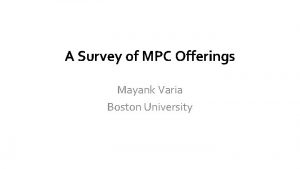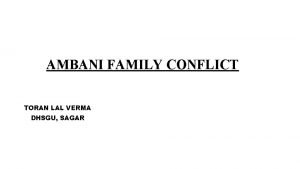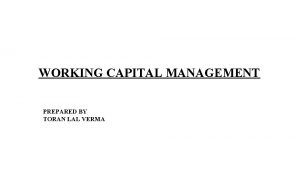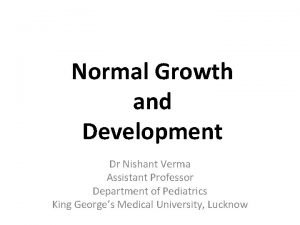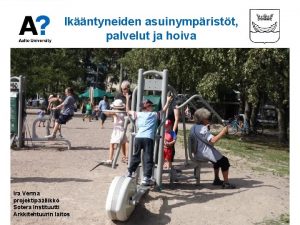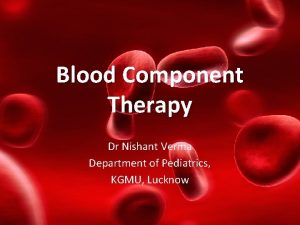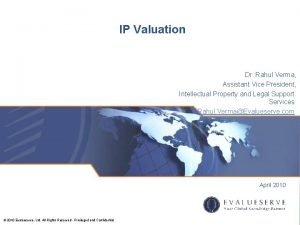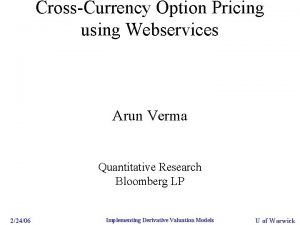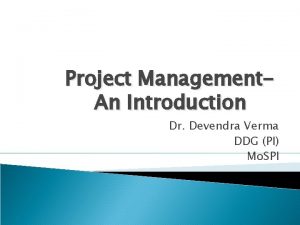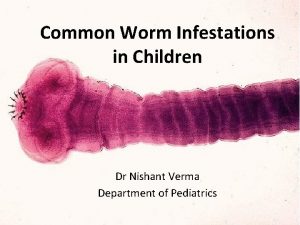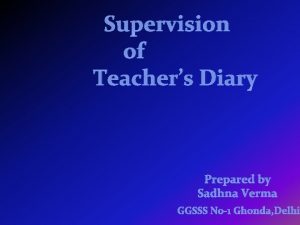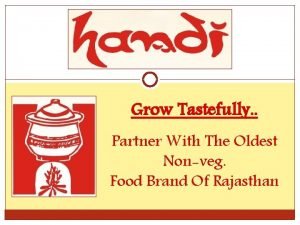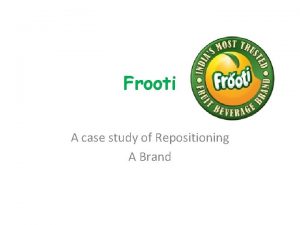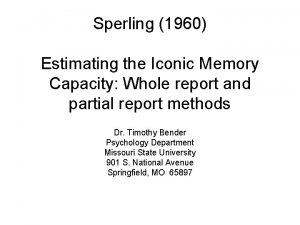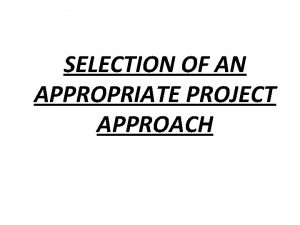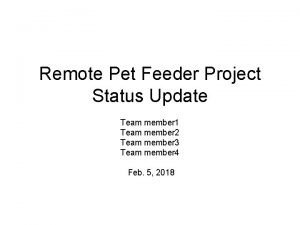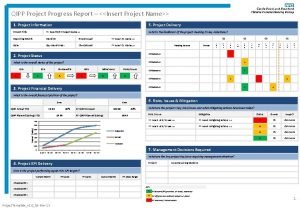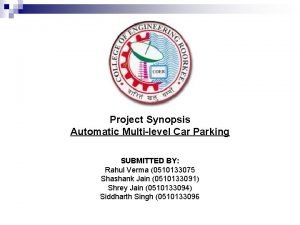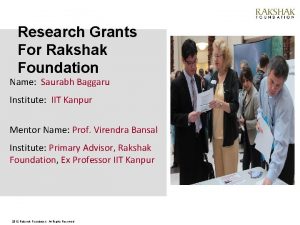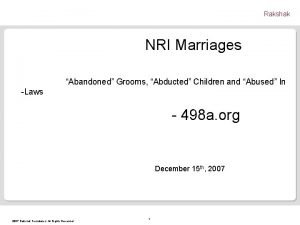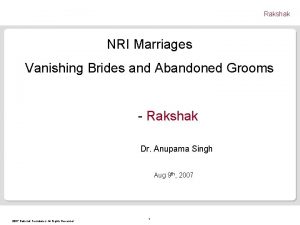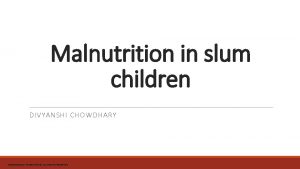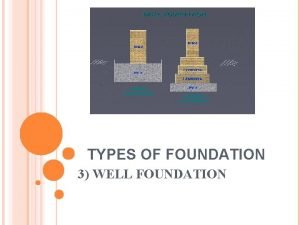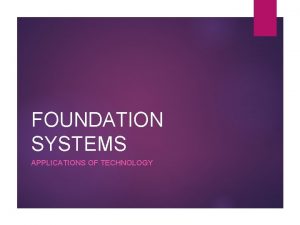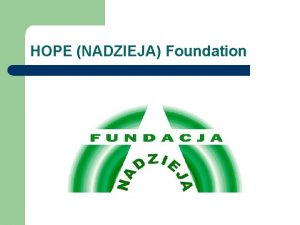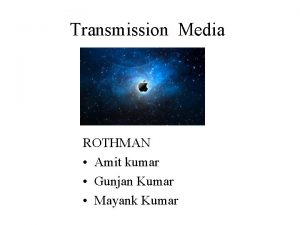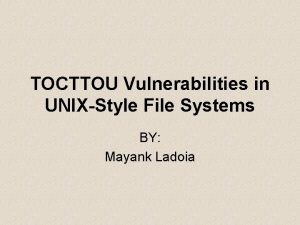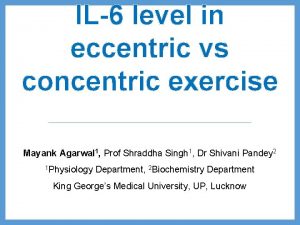Project Report Mayank Verma 100514 2012 Rakshak Foundation
































- Slides: 32

Project Report Mayank Verma 10/05/14 2012 Rakshak Foundation. All Rights Reserved.

Contents § Project Overview Introduction Goals and Objectives Scope of the project § Research Methodology for the project § Field visits and Mentor Discussion § Key Findings § Results and Discussions § Recommendations, their scope and Strategy for Implementation § Time Line § Appendix § References 2012 Rakshak Foundation. All Rights Reserved. 2

Project Overview § Introduction § Public Distribution System was set-up to provide food security by 1. Controlling the prices of essential food grains 2. Ensuring the availability of specific essential commodities throughout the year § Three different stages in the evolution of Public Distribution System 1. Universal Pubic Distribution System (UPDS) 2. Targeted Public Distribution System (TPDS) 3. National Food Security Act (NFSA) 2012 Rakshak Foundation. All Rights Reserved.

Goals and Objectives § To review the current Public Distribution System of India and propose measures that can overcome the shortcomings of the system and increase its efficiency in achieving its target. § Providing an overview of the different stages in the evolution of Public Distribution System to understand the need for review of the system. § Gather information about the supply chain system of the current Public Distribution System. § Review the current control measures and checking system on various levels of Public Distribution System. § Review of the various initiatives taken up by the government to understand the feasibility and efficiency issues in their nationwide implementation. § Studying the allocation of food grains in states with high PDS user population 2012 Rakshak Foundation. All Rights Reserved. 4

Goals and Objectives § Analyzing the cost incurred by the government in supporting the system § Analyzing the efficiency of the e-portals related to PDS designed on state and central level § To conduct a detailed survey of FPS owners and PDS card holders to understand the issues faced by the consumers and the cause of those issues. § Propose various measures that can be incorporated in the current PDS to increase its efficiency. 2012 Rakshak Foundation. All Rights Reserved. 5

Scope of the project § Despite the improvements and the claims of surplus accumulation of food grains than the prescribed buffer stock in the godowns of the Food Corporation of India, India still has around 25 percent of the world’s hungry poor § Forty eight percent of under-five aged children are malnourished which is over one-third of the world’s 150 million malnourished under-five age population. § India was ranked as high as 65 in 2009 with a global hunger index of 23. 9. § A country on its way to become a developed nation cannot deserve to be a country where people suffer due to hunger. § This shows that there is a severe need to review the current Public Distribution System and provide measures to strengthen it. 2012 Rakshak Foundation. All Rights Reserved. 6

Research Methodology § Literature Search 1. The research report on Food Security and Targeted Public Distribution System: To understand the basis of Public Distribution System and the need to shift from the Universal PDS to Targeted PDS 2. The Public Distribution System review in the Tenth Five Year Plan (2002 -2007) report by Planning Commission: To understand the impact of Targeted PDS since its introduction 3. The National Food Security Act, 2013: To understand the changes in prices and allocation of food grains to the families belonging to various categories under Targeted PDS. 2012 Rakshak Foundation. All Rights Reserved. 7

Research Methodology § Field Visits 1. Field visits to Food Commission Office of Lucknow: To understand the organizational structure and functioning of Public Distribution System 2. Field visits to Fair Price Shops: To understand review the functioning of Fair Price Shops § Surveys 1. A detailed survey of PDS card holders: To understand their requirements and issues, to identify the gap existing between their requirements and current system 2. Survey of Fair Price Shop owners: To understand the issues encountered in proper functioning of FPS 2012 Rakshak Foundation. All Rights Reserved. 8

Field visits and Mentor Discussion Sr. No Date and Person or time Organization Place Aim Findings 1 07/04/14 6: 30 -8: 30 PM Shri Ashish Gupta Lucknow Project details and meetings Aim and objective of the project References of ministry officials 2 09/04/14 3: 30 -6: 30 PM Smt Archana Aggarwal Food Commission Lucknow Supply chain system of PDS An overview(history, evolution) about PDS Identify the beginning and end of Supply chain of PDS 3 14/04/14 1: 00 -3: 30 PM Shri S. K. Singh Food Commission Lucknow Information regarding current PDS The hierarchical structure of Food Commission Office The mechanism of supplychain involved in PDS 2012 Rakshak Foundation. All Rights Reserved. 9

Field visits and Mentor Discussion Sr. No Date and Person or time Organization Place Aim Findings 4 28/04/14 4 -5 PM Shri Ashish Gupta Lucknow Designing of questionnaire Detailed questionnaires for FPS owners and PDS card holders 5 26/05/14 5 -7 PM Shri Ashish Gupta Lucknow Analysis and Formal discussion on the recommendati findings and proposed on based on recommendations the findings 2012 Rakshak Foundation. All Rights Reserved. 10

Key Findings • The Delhi region has a stable system with very small number of complaints. The families are contended with the quality of the food grains. However, the BPL and AAY families which are termed as priority households find it difficult to satisfy their requirements as they are not able to pay the market prices of the additional food grains purchased. • The equality of prices between all the categories is not a good practice as clearly APL families are comfortable in paying a higher amount for the commodities. Thus the government can reduce its subsidy expenditure by transferring the overhead expenses on to the APL families by marginally increasing the prices. • The e-portals of the states are not properly updated as they do not display the recent change in prices after the enactment of National Food Security Act, 2013. The central e-portal “PDS Portal of India” do have up to date information however the information related to many states is absent from the portal. Being a central portal, the portal should collaborate with state portal in order to be a central hub of information which can reduce the inefficiency due to the time lag caused by the paperwork. 2012 Rakshak Foundation. All Rights Reserved. 11

Key Findings • The Haryana Public Distribution System has excluded Above Poverty Line families from subsidized allocation and has a Below Poverty Line comprising of both Central Below Poverty Line and State Below Poverty Line households. One of the major issue is the suspension of certain Fair Price Shops thereby causing overburden of allocation and stocking of foodgrains on other fair price shops functioning in the region. • The Uttar Pradesh Public Distribution System has continued differential pricing of foodgrains across APL, BPL and AAY categories. However, the allocation has been normalized to 35 Kg. per card across all the categories. The base year for calculation of allocation of fair price shops in an area has not been updated since 2001 and thus has caused a burden on fair price shops of accommodating higher number of families than the prescribed norm of 4000 units per fair price shop. 2012 Rakshak Foundation. All Rights Reserved. 12

Results and Discussions • Findings from the literature • • 1. 2. Universal Public Distribution System was introduced to provide food security. A mechanism to control prices and ensure the availability of food grains throughout year Major issue in UPDS was that low income group were not able to get the benefit Reasons: The BPL families did not have proper knowledge about the PDS (allocation, issue prices) higher income families procured large quantities of food grains making the supply insufficient to fulfil the food grain needs of Below Poverty Line families. • Targeted Public Distribution System was introduced in June 1997 • The families were divided into three categories with respect to their income level: 1. Above Poverty Line (APL) 2. Below Poverty Line (BPL) 3. Antyodaya Anna Yogana (AAY) • The states were given the responsibility to identify the families that fall under each category and establish a pricing mechanism • Why Subsidize: Availability of food grains was not the only condition to provide food security. It was also necessary that the poor had the means to purchase the available food grains 2012 Rakshak Foundation. All Rights Reserved. 13

Results and Discussions • Finding from the fields and impact on theoretical focus of the project 1. Organizational Structure of Public Distribution System • 1. 2. 3. The Supply Chain system of PDS: Government of India: Allocation of food grains under PDS to state by FCI State Government: Procurement from FCI godowns and stocking in state godowns State Godowns: Allocate and ensure systematic procurement of food grain by each Fair Price Shops 4. Fair Price Shops: Distribution of food grains to families. 1 FPS per 4000 units • Four stage checking system in PDS: 1. Gazette Officers: Physical capacity verification to ascertain the efficient 2. State government employee: He/She ensures that the procurement is in accordance with the date specified and the allocation to the FPS. 3. Gram Vikas Adhikari: He/She verifies the incoming stock of the FPS, to ensure there are no discrepancy in the allocation from godown and the stock reaching the FPS. This verification in done during 1 st-4 th day of the month. 4. Gram Committee/ District Supplies Officer: Verifies complete distribution of the stock. Provides the FPS owner with a Praman Patra (Verification Notice) that has to be submitted to the godown inspector to issue next stock from the godown. 2012 Rakshak Foundation. All Rights Reserved. 14

Results and Discussions 2. An analysis of Delhi Region Commodity • • • APL BPL and Antyodaya (AAY) Allocation Price/Kg Wheat 4 Kg/Person 7. 05 4 Kg/Person 2 Rice 1 Kg/Person 9. 25 1 Kg/Person 3 Sugar NA NA 6 Kg/Card 13. 5 40 households of Delh in Seemapuri and Shahdara were covered. The survey of 4 Fair Price Shops of the area was also conducted. The results are as follows: 90 percent (36 out of 40) of the households were PDS card holders. The family income of 80 percent of households was in the range of 10, 000 -50, 000 per annum. These families constituted of both APL and BPL card holders. The major issue cited by the non-PDS households was that they were not provided newly issued PDS cards and ration was not being provided on previous cards. The family income of these household was in the range of 10, 000 -50, 000 per annum which constitutes priority card holder category. Out of 40 households, 18 households were BPL card holders (Yellow colour card) and the remaining 22 were APL card holders (White colour card). All the PDS card holder families purchased and in totality of their prescribed allocation from the Fair Price Shops. The families were aware of the allocation as it was duly stated on the boards in Fair Price Shops. 2012 Rakshak Foundation. All Rights Reserved. 15

Results and Discussions An analysis of Delhi Region (cont. ). • The BPL families stated that their food grain requirements were fulfilled by the current allocation. • However this was majorly due to huge difference between the market price and the issue price of FPS. BPL families could not pay these high prices and thus limited their consumption to the amount of food grains procured from FPS. • The card holders were satisfied by quality of food grains provided by FPS. • There were few instances of bad quality wheat issued by FPS (1 -2 time in the previous year). The families were however reluctant to file a complaint even when they were aware that District Grievance Redressal Officer (DGRO) are assigned to address the issues. • The families that did went to complain (4 out of 40) received a positive response and the issue was resolved within 15 days. • However, as stated by FPS owners, the supply to FPS is done at late hours and they have to accept whatever quality is provided. Also, being the election year, the monthly supplies were delayed to an extent of 7 -10 days. • When asked for their opinion on whether they would prefer direct subsidy transfer or food coupons, the majority of the families (33 out of 40) preferred food coupons. • The reasons cited were: 1. The uncertainty of timely transfer of cash to their accounts. 2. The uncertainty of the prices of the commodity. 2012 Rakshak Foundation. All Rights Reserved. 16

Results and Discussions An analysis of Haryana Region. Commodity BPL Allocation Price/Kg Wheat 3 Kg/Person 2. 00 Sugar Max. 2 Kg/Card 13. 50 Kerosene Max. 8 ltr/Card 13. 63 Total 5 Kg. /Unit Allocation and Prices in Haryana Commodity Wheat Sugar Kerosene Commission (in INR) 32 71 438 Antyodaya Anna Yojana Allocation Price/Kg 2. 00 Max. 2 Kg/Card 13. 50 Max. 8 ltr. /Card 13. 63 35 Kgs. /Card Quantity per quintal per Kilo Litre The commission of Fair Price Shops APL BPL(CBPL Antyodaya +SBPL) State Allocation (in MT) NA 108989. 6 211881. 3 Expenditure (in Cr. ) NA 5. 44 37. 33333 Allocation and Expenditure of Haryana for year 2013 -14 2012 Rakshak Foundation. All Rights Reserved. Antyodaya BPL(CBPL+S BPL) State Allocation (in MT) NA 113731 128813. 4 Expenditure (in Cr. ) NA 5. 69 25. 47 Allocation and Expenditure of Haryana for year 2012 -13 17

Results and Discussions An analysis of Haryana Region (cont. ) • A survey of PDS card holders and FPS shops of Gurgaon and Sona region of Haryana was conducted BPL Antyodaya No. of families 25 10 4 Avg Members 6 4 8 5/unit NA 35/card Allocation • The families were aware of the prescribed allocation however there is no allocation of Rice in the state PDS and it has been substituted with equal allocation of wheat to the families. The colour of the cards were Yellow, Green and Pink for BPL, APL and AAY respectively. The prices to BPL and AAY were subsidized, however APL card holders also received 5 kg/unit foodgrains at a price charged at 100 percent of the economic value. This price was comparatively lower than the market price thus APL families with relatively lower income still preferred to purchase from the Fair Price Shops. • An additional facility of wheat grinding was available at the fair price shops with a rate of Rs. 2 -3/Kg. which was lower than the rates charged by other shops (Rs. 4 -5/Kg. ). This was beneficiary both to the PDS card holders and FPS owners. The card holders could directly get wheat flour instead of making an additional trip to the grinding shop and that too at a lower price. It also provided an extra source of income to the FPS owners in order to compensate low commission rates. Thus the FPS owners were not concerned about the low commission rates. 2012 Rakshak Foundation. All Rights Reserved. 18

Results and Discussions An analysis of Haryana Region (cont. ) • A major anomaly witnessed was the long term suspension of some fair price shops which resulted in overburden on both stock and manpower on the nearby fair price shops. The average suspension duration noted of 3 fair price shops were above 6 months and was resulting in issues in proper distribution of foodgrains. The government should be more active in the cases of suspension as it would directly impact the supply-chain of the system. Whatever maybe the reason of suspension, the government should provide a deadline for resuming the functioning of fair price shop by resolving the issues quickly and take the required steps. • Apart from these issues, no major quality or supply issue was stated by the families and most of the families were content with the allocation. • A major environment issue that could be caused was providing subsidized kerosene to the PDS card holders. The government should take measures to promote use of LPG or PNG by reducing or alleviating the subsidy on kerosene. The initial implementation can be done at regions where LPG or PNG connection are available in order to prevent chaos by sudden change in the subsidy or allocation of the kerosene. . 2012 Rakshak Foundation. All Rights Reserved. 19

Results and Discussions An analysis of Uttar Pradesh Region Commodity . BPL Antyodaya Anna Yojana Allocation Price/Kg Allocation Price Wheat 23 Kg/Card 4. 65 - 2 23 Kg/Card 6. 6 Rice 12 Kg/Card 6. 15 - 3 12 Kg/Card 8. 45 Sugar 700 g/unit 13. 50 700 g/unit 13. 5 NA NA Kerosene 3 -5 ltr/Card 12. 5 -13. 5 3 -5 ltr/Card 13. 5 Total 35 Kg. /Card 35 Kgs. /Card Allocation and Prices of Uttar Pradesh region APL BPL AAY Total 2013 -14 231945 230475 143290 605710 2014 -15 154630 230457 143308 528395 Comparison of Allocation of U. P for year 2013 -14 and 2014 -15 2012 Rakshak Foundation. All Rights Reserved. 20 35 Kg. /Card

Results and Discussions An analysis of Uttar Pradesh Region A survey of 39 PDS card holder households and 4 fair price shops from Ghaziabad and Lucknow region was conducted to identify certain issues related to the functioning of state public distribution system. The details of the survey is as follows: BPL Total Avg Member APL AAY 21 10 8 8 7 8 The basic commodities like wheat and rice are issued from 5 th to 21 st of every month through fair price shops. For specific commodities like kerosene and sugar certain days specified as Vishesh Vitran Divas are communicated through local newspapers to inform the card holders about the days when the specific commodity would be distributed through fair price shops. Normally 3 days are allocated for the distribution of these commodities every month. This mechanism helps in keeping the damage in check as the dates of distribution of these fragile commodities are usually the next day of the arrival of the commodity at the fair price shops. A roaster is kept both at the godowns and fair price shops specifying the dates of procurement and distribution of the commodity. 2012 Rakshak Foundation. All Rights Reserved. 21

Results and Discussions An analysis of Uttar Pradesh Region • The distribution of the commodities through fair price shops was done smoothly however despite the state specification of 1 fair price shop for 4000 units, the fair price shops were overburdened as the average coverage of fair price shops was estimated at around 50006000 units. The major reason was the relative high increase in the population compared to the rate of introduction of new fair price shops. The allocation of fair price shops is conducted on the basis of information received through Census 2011 and in the next three years there has been an increase in the number of members per card and new card holders. • However the issue related to increase in number of members per card was addressed by introducing allocation on per card basis for each category. The basis year for population estimation is 2001 and has not been updated since then. This has caused an imbalance between the demand allocation of the state. The improper specification of allocation of a particular commodity (mainly wheat and rice) has also caused an imbalance in the supply chain of PDS. To counter the issue 8 regions of the state namely Faizabad, Varanasi, Devipatan, Allahabad, Mirzapur, Gorakhpur, Basti and Azamgarh have normalised AAY allocation to 10 Kg. Wheat and 20 Kg. Rice. It is necessary to specify the allocation of these commodities in other regions to support a consistent supply chain system by preventing the deficiency or excess of a particular commodity due to over or underallocation to the region. 2012 Rakshak Foundation. All Rights Reserved. 22

Recommendations, their scope and Strategy for Implementation Recommendation: In Delhi, the prices of commodities have been equalized throughout all the categories. However, after analyzing the current condition some changes can be implemented: 1. Increase monthly allocation of BPL from 5 to 6 kilograms person by increasing the allocation of wheat to 5 kilograms and keeping rice allocation constant. This would be able to completely satisfy the requirements of BPL families. 2. Increase allocation of AAY from 35 to 40 kilograms per card as it became evident that the families were larger in size and being in AAY was resulting in a lower allocation with respect to equal sized BPL families. 3. Increase the commission of FPS owners to Rs 50 per quintal. 4. Increase the issue prices of APL to incorporate the additional expense (transportation and commission expenses) in the prices of commodity. The transportation expense is Rs 60 per quintal and new commission expense is Rs. 50 per quintal. Scope: A reduction in government expenditure on subsidy under PDS by Rs. 2. 33 crores along with increase in allocation of BPL families to 6 kg person and AAY to 40 kgs. per card. 2012 Rakshak Foundation. All Rights Reserved. 23

Recommendations, their scope and Strategy for Implementation New Expenditure after the implementation of the recommendation (in Rs. ‘ 000) Flowchart: Current allocation of Delhi category wise AAY BPL APL Rice 1502 2765 8121 Wheat 3755 6293 27474 New Govt Exp Rice Wheat (in ‘ 000 Kg) AAY BPL APL 8936. 9 16866. 5 43041. 3 20464. 75 36578. 06 112643. 4 29401. 65 53444. 56 155684. 7 68844. 7 169686. 2 238530. 9 Difference between Economic value and issue price Rice Wheat Economic Value CIP 8. 3 6. 1 New issue prices of commodities as per the recommendation Difference 3 5. 3 2 4. 1 Issue Price Rice Wheat Government Expenditure as per current prices and allocation (in Rs. ’ 000) Govt Exp. AAY BPL APL Total Rice 8711. 6 16451. 75 50756. 25 75919. 6 Wheat 17273 29891. 75 138743. 7 185908. 5 Total 25984. 6 46343. 5 189500 261828. 1 2012 Rakshak Foundation. All Rights Reserved. 24 AAY BPL 3 2 APL 3 2 4. 1 3. 1

Recommendations, their scope and Strategy for Implementation Recommendation: . 1. Identify the family income of the households from the data provided by the current Census (Census 2011), sort the families according to income to identify bottom 75 percent rural households and 50 percent urban households. The income thus derived can be used as a benchmark to identify the Eligible households. 2. Maintain the status quo of the Antyodaya Anna Yojana family, however normalize the base year to the current Census year (2011) to correctly identify the number of families coming under AAY. The income limit is to be maintained at 15, 000 per annum. 3. For Priority Households, instead of a per unit allocation, implement a per card allocation in order to prevent overburden on PDS to accommodate the large families and promote family planning among these households. The allocation should be limited to 30 Kg. /Card with an option of review. This limit is identified by considering a family of 6 persons including a 2 children limit. For any increase in the number of children above this limit there would be no increase in the allocation, however if an adult member is included in the card beyond the limit of 6, an increase in allocation of 4 Kg. /card would be provided which would successively decrease i. e. increase of 3 Kg. /card for the 8 th member, 2 Kg. /card for the 9 th member and so on. This would reduce the burden on the system to accommodate large families and promote family planning. It would also result in a decrease in the duplication of members on multiple cards. 2012 Rakshak Foundation. All Rights Reserved. 25

Recommendations, their scope and Strategy for Implementation Scope: A proper estimation of the required allocation while considering the coverage of families as recommended by the committee. The resulted allocation is 62452. 72 tons. This allocation would be able to suffice the requirement of 49. 89 percent of the population. Flowchart: Following is the flowchart for Haryana State: Estimated Population and coverage under NFSA, 2013 (in Lacs) Population . Coverage Rural Urban Total 165. 315 88. 216 253. 531 90. 28 36. 21 126. 49 As per the recommendation by Socio Economic and Caste Census (SECC) 54. 61 percent of rural and 41. 05 percent of urban population is the target. Total coverage for the state would be 49. 89 percent of the population Category-wise estimate of population and number of families: (in Lacs) AAY Priority Households Rural Urban Total Families 8. 26575 4. 4108 12. 67655 1. 584569 82. 01425 31. 7992 113. 8135 18. 96891 2012 Rakshak Foundation. All Rights Reserved. 26 The AAY population has been estimated as 5 percent of the total population as the criteria set by the government To calculate the number of families, the average family size as derived from the survey results (8 for AAY and 6 for BPL) was used.

Recommendations, their scope and Strategy for Implementation Allocation to the estimated number of families as per the recommendations: (in Tons) Rural Urban Total AAY 3616. 266 1929. 725 5545. 991 Priority Households 41007. 13 15899. 6 56906. 73 The allocation is as per the recommendation of 35 Kg. for AAY and 30 Kg. for Priority households. Since in the survey the average family size of these families was 6, thus no additional allocation is required 2012 Rakshak Foundation. All Rights Reserved. 27

Timeline (Tasks Completed) Week 1 Project details and formulation of the tasklist Analyzing the research papers to understand the evolution of PDS. Week 2 Meetings with Food Commission officials to understand the operational structure of PDS Week 3 Contemplating the findings from the field visit, understanding the role of governing bodies and checking system of PDS Week 4 Designing the questionnaires for PDS card holders and FPS owners Conducting a pilot survey to know the efficiency of the questionnaire 2012 Rakshak Foundation. All Rights Reserved.

Timeline (Tasks Completed) Week 5 Survey of PDS card holders and FPS owners in Delhi region Formulate a strategy from the information received Week 6 Survey of PDS card holders and FPS owners of Haryana (Gurgaon region) Formulate a state level strategy from the information Week 7 Survey of PDS card holders and FPS owners of U. P (Ghaziabad, Lucknow region) Formulate a strategy based on the data Week 8 Contemplate the findings of the report and propose measures to strengthen the system Submission of final report 2012 Rakshak Foundation. All Rights Reserved.

APPENDIX Total number of families surveyed: 114 Total number of members (units): 770 Households Total Members 11% 12% 33% APL 26% BPL 56% Distribution of households surveyed by category 2012 Rakshak Foundation. All Rights Reserved. APL BPL AAY 62% Distribution of total members of the surveyed family

APPENDIX Average Units/Card Average Allocation/Card 9 40 8 35 7 30 6 25 5 20 4 15 3 2 10 1 5 0 0 APL BPL AAY Category-wise calculation of Average Units (members) per card 2012 Rakshak Foundation. All Rights Reserved. APL BPL AAY Category-wise calculation of average allocation per card

REFERENCES • Dr. Ruth Kuttumuri “Food Security and Targeted Public Distribution System in India”, LSE Asia Research Centre (38)(2011): 10 -23 • Planning Commission “Public Distribution System”, Tenth Five Year Plan (20022007): 365: 380 • Zhang Yue Zhou and Guanghua Wan “The Public Distribution Systems of Foodgrainsand Implications for Food Security” (98)(2006): 11 -22 • National Food Security Act, 2013 • http: //www. pdsportal. nic. in/ • http: //fcs. up. nic. in/upfood/fcsportal/Food. Portal. aspx • http: //haryanafood. gov. in/ • Planningcommission. nic. in • Dfpd. nic. in • http: //www. delhi. gov. in/wps/wcn/Home 2012 Rakshak Foundation. All Rights Reserved.
 Mayank varia
Mayank varia Dr mayank singh
Dr mayank singh Mayank tandon
Mayank tandon Sanmati verma
Sanmati verma Dhsgu
Dhsgu Toran lal verma
Toran lal verma 2 finger pincer grasp
2 finger pincer grasp Munindra verma
Munindra verma Kaupunkiakatemia
Kaupunkiakatemia Dr nishant verma kgmu
Dr nishant verma kgmu Nishant verma md
Nishant verma md Abhishek verma google
Abhishek verma google Dr rahul verma
Dr rahul verma Arun verma bloomberg
Arun verma bloomberg Dr s n verma
Dr s n verma Nitun verma
Nitun verma Dr devendra verma
Dr devendra verma Dr nishant verma gastroenterologist
Dr nishant verma gastroenterologist Sonam verma
Sonam verma Sadhna verma
Sadhna verma Dr. narsingh verma
Dr. narsingh verma Sprue wax composition
Sprue wax composition Sanjay verma
Sanjay verma Digen verma
Digen verma Raft foundation vs pad foundation
Raft foundation vs pad foundation Foundation standard 1 academic foundation
Foundation standard 1 academic foundation Difference between status report and progress report
Difference between status report and progress report Using the partial report method sperling
Using the partial report method sperling Wireless power transmission project report doc
Wireless power transmission project report doc Selection of an appropriate project report
Selection of an appropriate project report Automatic pet feeder project report
Automatic pet feeder project report How to report project progress
How to report project progress Multi level car parking system project report
Multi level car parking system project report
